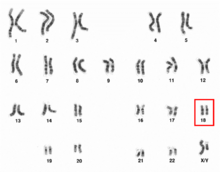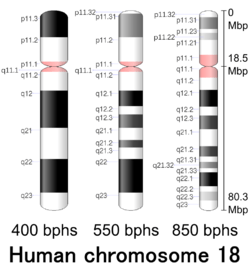Chromosome 18
Chromosome 18 is one of the 23 pairs of chromosomes in humans. People normally have two copies of this chromosome. Chromosome 18 spans about 80 million base pairs (the building material of DNA) and represents about 2.5 percent of the total DNA in cells.
| Chromosome 18 | |
|---|---|
 Human chromosome 18 pair after G-banding. One is from mother, one is from father. | |
 Chromosome 18 pair in human male karyogram. | |
| Features | |
| Length (bp) | 80,373,285 bp (GRCh38)[1] |
| No. of genes | 261 (CCDS)[2] |
| Type | Autosome |
| Centromere position | Submetacentric[3] (18.5 Mbp[4]) |
| Complete gene lists | |
| CCDS | Gene list |
| HGNC | Gene list |
| UniProt | Gene list |
| NCBI | Gene list |
| External map viewers | |
| Ensembl | Chromosome 18 |
| Entrez | Chromosome 18 |
| NCBI | Chromosome 18 |
| UCSC | Chromosome 18 |
| Full DNA sequences | |
| RefSeq | NC_000018 (FASTA) |
| GenBank | CM000680 (FASTA) |
Genes
Number of genes
The following are some of the gene count estimates of human chromosome 18. Because researchers use different approaches to genome annotation their predictions of the number of genes on each chromosome varies (for technical details, see gene prediction). Among various projects, the collaborative consensus coding sequence project (CCDS) takes an extremely conservative strategy. So CCDS's gene number prediction represents a lower bound on the total number of human protein-coding genes.[5]
| Estimated by | Protein-coding genes | Non-coding RNA genes | Pseudogenes | Source | Release date |
|---|---|---|---|---|---|
| CCDS | 261 | — | — | [2] | 2016-09-08 |
| HGNC | 262 | 138 | 241 | [6] | 2017-05-12 |
| Ensembl | 268 | 608 | 247 | [7] | 2017-03-29 |
| UniProt | 276 | — | — | [8] | 2018-02-28 |
| NCBI | 285 | 432 | 304 | [9][10][11] | 2017-05-19 |
Gene list
The following is a partial list of genes on human chromosome 18. For complete list, see the link in the infobox on the right.
- ASXL3: encoding protein Additional sex combs like 3 (Drosophila)
- CABLES1: encoding protein CDK5 and ABL1 enzyme substrate 1
- CABYR: Calcium-binding tyrosine phosphorylation-regulated protein
- CHMP1B: Charged multivesicular body protein 1b
- CXXC1: CXXC-type zinc finger protein 1
- DCC: Deleted in Colorectal Cancer
- ELAC1: elaC ribonuclease Z 1
- ESCO1: encoding protein Establishment of sister chromatid cohesion N-acetyltransferase 1
- FAM69C: encoding protein Family with sequence similarity 69, member C
- FECH: ferrochelatase (protoporphyria)
- GREB1L: encoding protein Growth regulation by estrogen in breast cancer-like
- HAUS1: HAUS augmin-like complex subunit 1
- HDHD2: encoding enzyme Haloacid dehalogenase-like hydrolase domain-containing protein 2
- IER3IP1: encoding protein Immediate early response 3-interacting protein 1
- KC6: Keratoconus gene 6, discovery reported in 2005;
- MIR133A1: encoding microRNA MicroRNA 133a-1
- MIR187: encoding protein MicroRNA 187
- MRCL3: encoding protein Myosin regulatory light chain 12A
- NAPG: encoding protein Gamma-soluble NSF attachment protein
- NOL4: encoding protein Nucleolar protein 4
- NPC1: Niemann-Pick disease, type C1
- PIGN: encoding protein Phosphatidylinositol glycan anchor biosynthesis, class N
- PSTPIP2: encoding enzyme Proline-serine-threonine phosphatase-interacting protein 2
- RP11-267C16.1: encoding protein Uncharacterized LOC100287225
- SERPINB10: encoding protein Serpin peptidase inhibitor, clade B (ovalbumin), member 10
- SIGLEC15: encoding protein Sialic acid binding Ig-like lectin 15
- SMAD4: SMAD, mothers against DPP homolog 4 (Drosophila)
- TMEM241: encoding protein Transmembrane protein 241
- TTC39C: encoding protein Tetratricopeptide repeat protein 39C
- TWSG1: encoding protein Twisted gastrulation protein homolog 1
- ZCCHC2: encoding protein Zinc finger CCHC domain-containing protein 2
- ZFP161: encoding protein Zinc finger protein 161 homolog
- ZNF236: encoding protein Zinc finger protein 236
- ZNF516: encoding protein Zinc finger protein 516
- ZNF521: encoding protein Zinc finger protein 521
- ZNF532: encoding protein Zinc finger protein 532
Diseases and disorders
The following diseases are some of those related to genes on chromosome 18:
- Erythropoietic protoporphyria
- Hereditary hemorrhagic telangiectasia
- Niemann–Pick disease type C
- Porphyria
- Selective mutism
- Edwards syndrome (trisomy 18)
- Tetrasomy 18p
- Monosomy 18p
- Pitt–Hopkins syndrome 18q21
- Distal 18q- (distal deletion)[12]
- Proximal 18q- (proximal deletion)
Cytogenetic band
| Chr. | Arm[18] | Band[19] | ISCN start[20] |
ISCN stop[20] |
Basepair start |
Basepair stop |
Stain[21] | Density |
|---|---|---|---|---|---|---|---|---|
| 18 | p | 11.32 | 0 | 159 | 1 | 2,900,000 | gneg | |
| 18 | p | 11.31 | 159 | 430 | 2,900,001 | 7,200,000 | gpos | 50 |
| 18 | p | 11.23 | 430 | 526 | 7,200,001 | 8,500,000 | gneg | |
| 18 | p | 11.22 | 526 | 685 | 8,500,001 | 10,900,000 | gpos | 25 |
| 18 | p | 11.21 | 685 | 1035 | 10,900,001 | 15,400,000 | gneg | |
| 18 | p | 11.1 | 1035 | 1290 | 15,400,001 | 18,500,000 | acen | |
| 18 | q | 11.1 | 1290 | 1561 | 18,500,001 | 21,500,000 | acen | |
| 18 | q | 11.2 | 1561 | 1847 | 21,500,001 | 27,500,000 | gneg | |
| 18 | q | 12.1 | 1847 | 2229 | 27,500,001 | 35,100,000 | gpos | 100 |
| 18 | q | 12.2 | 2229 | 2436 | 35,100,001 | 39,500,000 | gneg | |
| 18 | q | 12.3 | 2436 | 2755 | 39,500,001 | 45,900,000 | gpos | 75 |
| 18 | q | 21.1 | 2755 | 3153 | 45,900,001 | 50,700,000 | gneg | |
| 18 | q | 21.2 | 3153 | 3392 | 50,700,001 | 56,200,000 | gpos | 75 |
| 18 | q | 21.31 | 3392 | 3519 | 56,200,001 | 58,600,000 | gneg | |
| 18 | q | 21.32 | 3519 | 3663 | 58,600,001 | 61,300,000 | gpos | 50 |
| 18 | q | 21.33 | 3663 | 3758 | 61,300,001 | 63,900,000 | gneg | |
| 18 | q | 22.1 | 3758 | 4077 | 63,900,001 | 69,100,000 | gpos | 100 |
| 18 | q | 22.2 | 4077 | 4204 | 69,100,001 | 71,000,000 | gneg | |
| 18 | q | 22.3 | 4204 | 4411 | 71,000,001 | 75,400,000 | gpos | 25 |
| 18 | q | 23 | 4411 | 4650 | 75,400,001 | 80,373,285 | gneg |
References
- "Human Genome Assembly GRCh38 - Genome Reference Consortium". National Center for Biotechnology Information. 2013-12-24. Retrieved 2017-03-04.
- "Search results - 18[CHR] AND "Homo sapiens"[Organism] AND ("has ccds"[Properties] AND alive[prop]) - Gene". NCBI. CCDS Release 20 for Homo sapiens. 2016-09-08. Retrieved 2017-05-28.
- Tom Strachan; Andrew Read (2 April 2010). Human Molecular Genetics. Garland Science. p. 45. ISBN 978-1-136-84407-2.
- Genome Decoration Page, NCBI. Ideogram data for Homo sapience (850 bphs, Assembly GRCh38.p3). Last update 2014-06-03. Retrieved 2017-04-26.
- Pertea M, Salzberg SL (2010). "Between a chicken and a grape: estimating the number of human genes". Genome Biol. 11 (5): 206. doi:10.1186/gb-2010-11-5-206. PMC 2898077. PMID 20441615.
- "Statistics & Downloads for chromosome 18". HUGO Gene Nomenclature Committee. 2017-05-12. Retrieved 2017-05-19.
- "Chromosome 18: Chromosome summary - Homo sapiens". Ensembl Release 88. 2017-03-29. Retrieved 2017-05-19.
- "Human chromosome 18: entries, gene names and cross-references to MIM". UniProt. 2018-02-28. Retrieved 2018-03-16.
- "Search results - 18[CHR] AND "Homo sapiens"[Organism] AND ("genetype protein coding"[Properties] AND alive[prop]) - Gene". NCBI. 2017-05-19. Retrieved 2017-05-20.
- "Search results - 18[CHR] AND "Homo sapiens"[Organism] AND ( ("genetype miscrna"[Properties] OR "genetype ncrna"[Properties] OR "genetype rrna"[Properties] OR "genetype trna"[Properties] OR "genetype scrna"[Properties] OR "genetype snrna"[Properties] OR "genetype snorna"[Properties]) NOT "genetype protein coding"[Properties] AND alive[prop]) - Gene". NCBI. 2017-05-19. Retrieved 2017-05-20.
- "Search results - 18[CHR] AND "Homo sapiens"[Organism] AND ("genetype pseudo"[Properties] AND alive[prop]) - Gene". NCBI. 2017-05-19. Retrieved 2017-05-20.
- "chromosome18". www.chromosome18.org. Retrieved 2017-01-19.
- Genome Decoration Page, NCBI. Ideogram data for Homo sapience (400 bphs, Assembly GRCh38.p3). Last update 2014-03-04. Retrieved 2017-04-26.
- Genome Decoration Page, NCBI. Ideogram data for Homo sapience (550 bphs, Assembly GRCh38.p3). Last update 2015-08-11. Retrieved 2017-04-26.
- International Standing Committee on Human Cytogenetic Nomenclature (2013). ISCN 2013: An International System for Human Cytogenetic Nomenclature (2013). Karger Medical and Scientific Publishers. ISBN 978-3-318-02253-7.
- Sethakulvichai, W.; Manitpornsut, S.; Wiboonrat, M.; Lilakiatsakun, W.; Assawamakin, A.; Tongsima, S. (2012). "Estimation of band level resolutions of human chromosome images" (PDF). In Computer Science and Software Engineering (JCSSE), 2012 International Joint Conference on: 276–282. doi:10.1109/JCSSE.2012.6261965.
- Genome Decoration Page, NCBI. Ideogram data for Homo sapience (850 bphs, Assembly GRCh38.p3). Last update 2014-06-03. Retrieved 2017-04-26.
- "p": Short arm; "q": Long arm.
- For cytogenetic banding nomenclature, see article locus.
- These values (ISCN start/stop) are based on the length of bands/ideograms from the ISCN book, An International System for Human Cytogenetic Nomenclature (2013). Arbitrary unit.
- gpos: Region which is positively stained by G banding, generally AT-rich and gene poor; gneg: Region which is negatively stained by G banding, generally CG-rich and gene rich; acen Centromere. var: Variable region; stalk: Stalk.
- Nusbaum C, Zody MC, Borowsky ML, Kamal M, Kodira CD, Taylor TD, Whittaker CA, Chang JL, Cuomo CA, Dewar K, FitzGerald MG, Yang X, Abouelleil A, Allen NR, Anderson S, Bloom T, Bugalter B, Butler J, Cook A, DeCaprio D, Engels R, Garber M, Gnirke A, Hafez N, Hall JL, Norman CH, Itoh T, Jaffe DB, Kuroki Y, Lehoczky J, Lui A, Macdonald P, Mauceli E, Mikkelsen TS, Naylor JW, Nicol R, Nguyen C, Noguchi H, O'Leary SB, O'Neill K, Piqani B, Smith CL, Talamas JA, Topham K, Totoki Y, Toyoda A, Wain HM, Young SK, Zeng Q, Zimmer AR, Fujiyama A, Hattori M, Birren BW, Sakaki Y, Lander ES (2005). "DNA sequence and analysis of human chromosome 18". Nature. 437 (7058): 551–5. doi:10.1038/nature03983. PMID 16177791.
- Chen H, Wang N, Huo Y, Sklar P, MacKinnon DF, Potash JB, McMahon FJ, Antonarakis SE, DePaulo JR Jr, Ross CA, McInnis MG (2003). "Trapping and sequence analysis of 1138 putative exons from human chromosome 18". Mol Psychiatry. 8 (6): 619–23. doi:10.1038/sj.mp.4001288. PMID 12851638.
- Gilbert F (1997). "Disease genes and chromosomes: disease maps of the human genome. Chromosome 18". Genet Test. 1 (1): 69–71. PMID 10464628.
External links
| Wikimedia Commons has media related to Human chromosome 18. |
- Chromosome18.org
- Chromosome18 Registry And Research Society in Europe.
- National Institutes of Health. "Chromosome 18". Genetics Home Reference. Retrieved 2017-05-06.
- "Chromosome 18". Human Genome Project Information Archive 1990–2003. Retrieved 2017-05-06.

